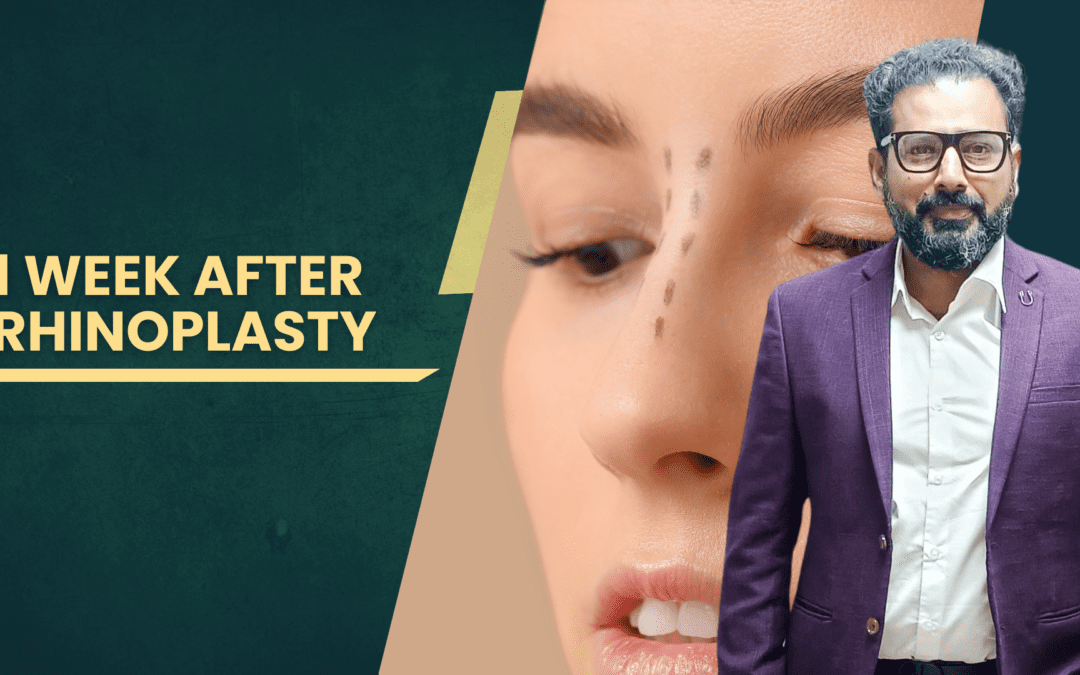“The journey to a refined, natural-looking nose doesn’t end with surgery—it’s just the beginning of your healing process.”
Undergoing rhinoplasty, commonly called a nose job, is a life-changing decision. As you navigate the recovery period, questions and concerns may arise, especially during the crucial first week after rhinoplasty.
“1 week after rhinoplasty marks an essential phase in your recovery journey, and it’s completely normal to have a mix of excitement and uncertainty. Understanding your body’s signals and following care instructions meticulously can make all the difference.” – Dr. Harikiran Chekuri, one of the best plastic surgeons in Hyderabad and Founder of Redefine Clinic.
At Redefine Plastic Surgery Clinic in Hyderabad, we understand that the post-surgery period can be filled with concerns, especially one week after rhinoplasty. Dr. Harikiran Chekuri and his team are committed to providing comprehensive post-operative care to ensure a smooth recovery and optimal outcomes.
What to Expect 1 Week After Rhinoplasty

During this time, the following are common:
- Swelling:It is natural for swelling to peak during the first week.
- Bruising:This is most noticeable around the eyes and nose.
- Nasal Congestion:Stuffy sensations due to internal swelling are typical.
- Pain or Discomfort:Manageable with prescribed medication.
By the end of the first week, your surgeon may remove the external splint if healing permits. However, internal swelling will continue to subside over the next few weeks.
It’s important to remember that every patient’s experience is unique. While some individuals may feel more discomfort, others may find the first week easier to handle. Much of this depends on your body’s natural healing response, the extent of the procedure, and your adherence to post-operative care instructions.
Is It Normal to Have Swelling 1 Week After Rhinoplasty?
Swelling is entirely normal 1 week after nose job. The body’s healing process naturally involves inflammation, which aids in recovery. At this stage of swelling 1 week post-rhinoplasty, you may notice:” You may notice:
- Puffiness around your cheeks and eyes
- A firm sensation in your nose
- Asymmetry due to uneven swelling
Swelling is not just limited to the external area. Internal nasal tissues also swell, contributing to congestion and difficulty breathing through your nose. This is a temporary issue and gradually improves with time. While it may be tempting to check your results at this stage, it’s crucial to remember that swelling will obscure the final shape of your nose for some time.
“Swelling is a sign that your body is healing. While it may feel uncomfortable, staying hydrated and following post-surgery guidelines helps expedite the process.” – Dr. Harikiran Chekuri, renowned for his expertise in rhinoplasty in Hyderabad.
How to Minimize Swelling 1 Week After Rhinoplasty

- Keep Your Head Elevated: Sleep with your head propped up on pillows to reduce fluid retention.
- Apply Cold Compresses: Use gently around the eyes (avoid direct contact with the nose).
- Follow Prescribed Medications: Anti-inflammatory medications can help.
- Avoid Strenuous Activities: Let your body focus on healing.
- Stay Hydrated: Flush out toxins and keep tissues healthy.
Avoiding salty foods can also help reduce water retention, contributing to swelling. Maintain a balanced diet rich in vitamins and minerals to support tissue healing. Additionally, avoid smoking or alcohol consumption, as these can delay recovery and exacerbate swelling.
When to Consult Your Surgeon

Although some discomfort is typical, specific symptoms warrant a visit to your plastic surgery clinic in Hyderabad:
- Severe or persistent pain unrelieved by medication
- Sudden or excessive bleeding from the nose
- Signs of infection like fever, redness, or unusual discharge
- Breathing difficulties beyond expected congestion
Regular follow-ups are essential for monitoring your healing progress. Your surgeon may check for potential complications during these appointments and provide personalized advice. Never hesitate to reach out if something feels off, as addressing issues promptly can prevent further complications.
“Your safety and comfort are top priorities. If anything feels amiss, it’s always better to check in with your surgeon.” – Dr. Harikiran Chekuri, trusted by patients as one of the top plastic surgeons in Hyderabad.
Before and After Rhinoplasty: A Transformative Journey
The first week after rhinoplasty is just the beginning of your journey. While swelling and bruising can obscure results, here’s what to anticipate as healing progresses:
- Week 1: Initial swelling and bruising, splint removal (if applicable).
- Week 2: Swelling begins to subside; bruising diminishes 2 weeks after rhinoplasty
- Months 1-3 :Shape refinement becomes noticeable as tissues settle.
- Months 6-12 :Final results become fully apparent.
Many patients report a boost in confidence after rhinoplasty. Seeing the initial changes can be exciting, even during the healing phase. Staying patient and trusting the process is essential, as the most refined results take time to emerge.
Conclusion
Frequently Asked Questions
Can I touch my nose 1 week after rhinoplasty?
Does the nose bleed 1 week after rhinoplasty?
How long does swelling last after rhinoplasty?
How soon can I return to work after rhinoplasty?
Will sneezing damage my nose after rhinoplasty?




